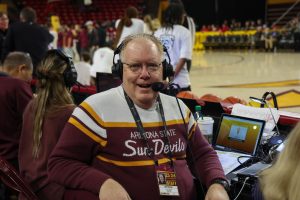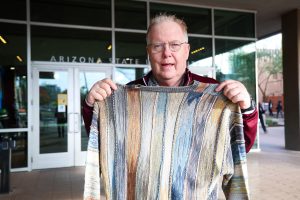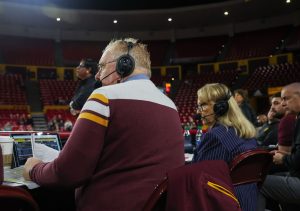- Slug: Sports-ASU Jeff Munn Sweaters, 1900 words
- 5 photos available (thumbnails, captions below)
By Maxwell Williams
Cronkite News
TEMPE – While watching a game of ASU women’s basketball, viewers naturally focus on the bright orange ball zipping its way around the hardwood. However, it’s not uncommon for a more vivid display of colors to steal the show courtside.
The sartorial choices of KTAR FM radio play-by-play broadcaster Jeff Munn are hard to miss.
Now decades in the making, Munn’s sweater collection adds a nice pop of color to the sideline, his bright threads providing a sharp backdrop to his game commentary. Maroons, golds, blues, greens, stripes and even pizza slices – if one can dream it, chances are Munn has a sweater for it. At the end of the day, Munn’s vibrant duds pay homage to his daughter Hayley, a 25-year-old filmmaker.
“She doesn’t watch the game. She doesn’t have Pac-12 Network, so that’s part of it, but it’s still my way of having a little connection between the two of us,” Munn said. “That’s why I call them the Hayley sweaters, because that’s exactly what I’m wearing it for.”
To understand the origin of the tradition, the 2004-05 season for the Sun Devils plays a crucial role. Munn was in his first season as broadcaster for the team, and with only a few regular season games shown on television, each occasion was special for then 6-year-old Hayley to see her dad on the small screen.
But he was hard to spot.
Who could have guessed that a young Hayley’s inability to recognize her dad from the camera angles of the broadcast would have resulted in this much flare in Munn’s future outerwear?
“When the camera’s moving in a lot of directions every few seconds, and you’re a parent trying to show your kids where your dad is because you think that’s the coolest thing in the world when you’re younger; it’s like my dad’s kind of on TV, but not really,” Hayley said.
As soon as he got back home from that first game, a plan was devised to be sure there was no chance that Hayley could miss her dad ahead of the Pac-10 Tournament in San Jose, California. It just so happened that the most easily recognizable piece of clothing he had was a sweater not unlike those worn in the office by former Phoenix Suns coach Lowell “Cotton” Fitzsimmons.
During that season, which culminated in a Sweet 16 appearance for coach Charli Turner Thorne and ASU, the Sun Devils earned a spot in the championship game of the Pac-10 Tournament, meaning a three-day trip for the team and Munn.
Munn stuck to his word and wore the same sweater all three days in a row, joking that Turner Thorne began questioning his belief in the team’s success, assuming that he only packed enough clothes for one day of competition. Little did she know that this was just the beginning of something great.
Knitwear as sweet as Munn’s collection is not exactly easy to come by, nor is his schedule very open.
Yet, Munn discovered that – if he timed it right – he could make a short trip north to the Flamingo Hotel in Las Vegas following the end of the baseball season when he was working with the Diamondbacks. A now-closed menswear store there unloaded its year-old collection of sweaters at a discounted price. Over time, this became an annual pilgrimage to replenish his stock.
“The more he started wearing them, the more people noticed and commented on them, and he ended up getting more and more,” said Maura McHugh, former ASU women’s basketball coach and Munn’s current KTAR FM color analyst. “It’s just really neat. My favorite is the pepperoni pizza one. I mean, you just can’t beat that one.”
Those who know him best can’t deny the positive relationship that Munn has with his children Hayley and Patrick, a 27-year-old working at a sheriff’s department and living in the Phoenix area.
“Hayley loved the game because she loved her dad, in my opinion,” Turner Thorne said. “And as crazy and demanding as his career is, he just really wants to be there for his kids.”
Hayley discovered other art-related hobbies that interested her more than keeping up with Sun Devil hoops, but her career choice never placed a barrier between her and her father as she grew up.
In fact, filmmaking gave Hayley a new perspective on her dad’s work.
“In a way, there’s art in sports as well with what the team colors are or how people dress up when they go there, how they express themselves or even what my dad does,” Hayley said. “When you see someone that you love, whether it’s a friend, or in my case a parent … doing what they love, that makes you happy.”
It’s difficult to not feed off the positive energy Munn brings to almost every conversation, not to mention all of the things a person can learn just by listening to a few of his stories. Lighthearted or heavy, basketball-related or not, he’s always ready to share the treasure trove of tales he has gained through decades of work in and around the Phoenix market.
Munn was a senior at Carl Hayden High School when he began his broadcasting career, one that has seen him serve as the voice for an eclectic collection of sporting events spread across decades and throughout hundreds of arenas. He has announced U.S. Figure Skating Championships, Olympic Games and the World Series. He has been a public address announcer for the Suns, Diamondbacks and the Fiesta Bowl and also worked as a backup play-by-play broadcaster for the Diamondbacks.
But it is his work with ASU women’s hoops since 2004 that defines his legacy.
There have been pitfalls along the way, though.
The colorful Arizona-born commentator is actually color blind, which led Munn to commit the heinous crime of wearing a crimson and gray sweater while donning the headset on a road trip to Washington State. The Cougars, of course, wear crimson and gray.
Luckily, an academic advisor traveling with the team saved the day just 10 minutes before tipoff, and unlike the Pac-10 Tournament incident at the start of his time with the Sun Devils, he came prepared with a backup this time.
“She looks at me and she says, ‘Are you aware of what you’re wearing?’ and I said, ‘No,’” Munn recalled with a chuckle.
Munn could fill an entire book with stories of his own, but the narratives of those closest to him give the bigger picture of his impact on others. A specific moment that stuck out to Hayley came while spending time at an unfamiliar house of a mutual friend in 2018.
At this point, Munn no longer worked for the Diamondbacks, but Hayley could faintly hear the familiar sound of a game coming from another room. Sitting in the dining room next to a personal radio was the partially blind father of her former boyfriend’s friend. Introducing herself, the two began to talk about the team.
“He said, ‘There was someone else who used to do those games a few years ago, and I miss when that person did that,’” Hayley said.
Taking an educated guess at who that might be, Hayley threw out her dad’s name and explained that she was his daughter. To her surprise, the man across the table perked up “as if he was a personal friend.”
“I swear to you, with his good eye, he looked at me as if I had just said he was Santa Claus,” Hayley said.
Without ever meeting the two-time Arizona Sportscaster of the Year, the man was just one of many who felt Munn could tell the story of the game better than anyone, regardless of the listeners’ ability to see the action taking place. Some even combine mediums just to have the best of both worlds.
“Jeff is so good that most of my family and friends, if they could, would listen to Jeff and turn off the volume of their TV if it was a TV game,” Turner Thorne said. “And by the way, Jeff always cued people to do that.”
Regardless of who has their eyes or ears piqued, to this day Munn pretends as if he is just having a one-on-one conversation with another person, which he feels is only possible through the radio medium.
“My mom has been dead since 1999, but I still do every broadcast like I’m talking to her,” Munn said. “I think to myself, ‘What would my mom want to know besides, how are my grandchildren?’ And to me, you can’t do that on TV.”
Hayley remembers toward the later stages of her grandmother’s life, she was placed in hospice care as she battled dementia. At the time, Munn was with the Diamondbacks where he served in positions like public address announcer, fill-in radio play-by-play and host of the team’s radio pregame and postgame show for 17 years. He began to describe the games “in a way that she could understand,” according to Hayley.
She said that her grandmother listened to Munn whenever she was able until she died, but that he never stopped calling the games for her. Comparing where he is now to his expectations at the start of his radio career working as a disc jockey for KWAO FM radio in Sun City in 1979 or even at the turn of the century, Munn is more than satisfied.
“If I had sat down at that time and made a list of what I reasonably think I can accomplish, I’ve gone way past that. Way, way past that,” Munn said.
In this grand finale of the Pac-12 Conference amid the trend of massive conference realignment, Munn said this season has been one of “incredible sadness” as the ASU women’s basketball team plays its final conference games in hallowed venues that burst with league history.
Though these road trips may never be the same, Munn has tried to stay optimistic about the future of ASU’s basketball programs as it transitions to the Big 12 Conference.
“My feeling is that when we get into it next year, the newness and the excitement of playing new schools will kind of override the sadness of saying goodbye to the Pac-12,” Munn said.
For now, his goal is to stick with the team in his current position through the seismic changes, and although new teams and different travel schedules will be introduced to the picture, viewers can bet their bottom dollar that the broadcaster will still be on the sidelines wearing one of his sweaters of many colors.
“I get tired on the road, and I’m not as enthused about going to the airport as I used to be,” Munn said. “But when the music starts and the pregame show starts, I’m still getting the same, ‘Oh boy, here we go!’
“I figure as long as I’m still doing that, we’ll keep going.”
For more stories from Cronkite News, visit cronkitenews.azpbs.org.




